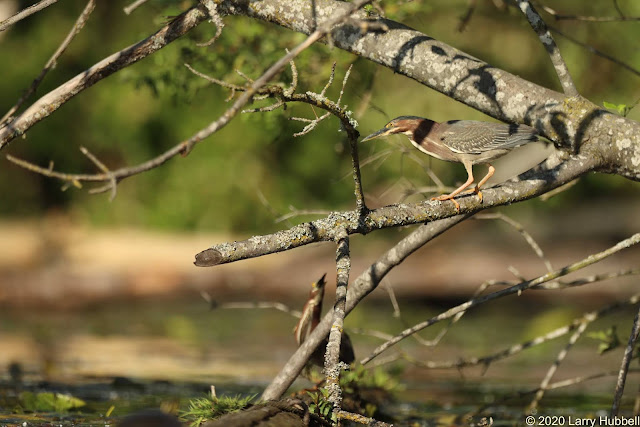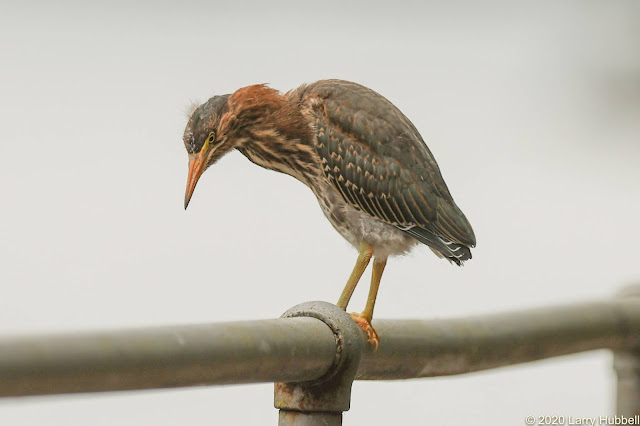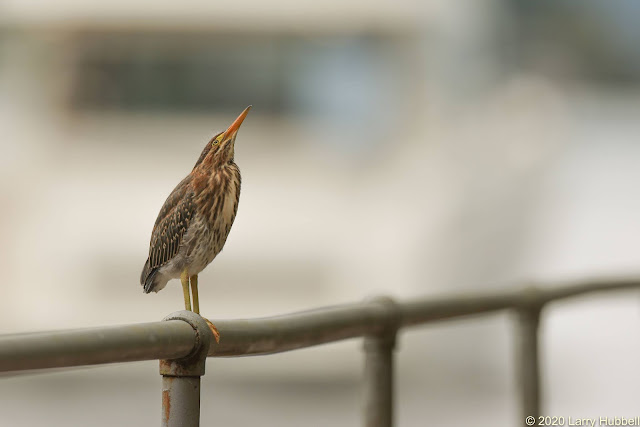 Green Herons are predators. Around Union Bay, I see them eating fish, frogs, and the occasional insect. Like humans, their eyes generally focus forward especially, when searching for food.
Green Herons are predators. Around Union Bay, I see them eating fish, frogs, and the occasional insect. Like humans, their eyes generally focus forward especially, when searching for food. | Unlike us, they can position their mouth, and their bill, above their eyes while still looking forward or even down. Compared to Great Blue Herons, Green Herons are relatively small, crow-sized birds, which makes them harder to see. Their eyes also protrude a bit, which helps them watch for danger approaching from behind. Almost any type of threat can cause them to flush. If you don't give a Green Heron a second glance, when it is in the air, you might easily assume it is an American Crow disappearing in the distance. Their patchwork coloring helps them to blend in with overhanging or reflected vegetation.  It is not uncommon to see them just holding their prey, apparently waiting for the struggling to stop.
You are less likely to observe the split-second when a Green Heron unleashes its secret weapon. A heron's coiled and hidden neck shoots the bill forward. It snags the prey. The neck retracts. In a flash, it is done. I suspect, the capture occurs before the prey even realizes it is in danger.
Green Herons also have a seldom-seen, tool-using tactic that compliments their secret weapon. Click Here to learn another way they can trick a fish.
|
It was near the end of May when I spotted this bird. Being human, I was focused on the heron in front of me and less observant of peripheral creatures. I did notice the turtles. Initially, I failed to see the second heron mostly-hidden behind the branches at the other end of the log.
When it stepped forward the movement caught my eye.
The bird in front of me turned to watch the second Heron's approach.
The rich coloring on the second bird implied maturity. I believe it was the male. Females tend to have similar, but less brilliant, colors, like the bird on the left.
Given the time of year and their willingness to hunt side-by-side, I took them for a mated pair.
I suspect the female might be the younger of the two - possibly a second year bird. I believe, her bill is too black and her legs are too orange to be in her first year.
Still, she seemed a bit nervous, like a young bird. Suddenly, she moved and landed on a branch above and behind the male.
He appeared irritated by her fidgeting - maybe she was disturbing the fish. He turned and seemed to squawk in her direction.
This was followed by a leap, landing part way up towards her perch. She took to the wing and put a little distance between them.
After a time, they appeared to calm down. They both flew to a branch, about 100 yards away. Here, the male is walking up the branch toward the female.
I have never seen nesting Green Herons. Given the time of the year, I was excited by the prospect. I was hoping I might see them nest building and maybe even watch them raise young.
Sadly, in June, I was distracted by other nesting birds. I did not see the Green Herons during nest building or while they were feeding their young. Occasionally, I did see a single bird flying north from Montlake Cut. Later in the summer, I saw one flying west, just like this. It was around mid-day. From my location near Monty and Marsha's eagle nest, I could not be sure if the heron flew over the bridge or landed in a nearby tree.
However, since The Cut does not contain the appropriate shallow water for hunting fish or frogs. I concluded the adult might have been bringing food to its offspring. I moved closer to the bridge and settled onto a bench on the south side of The Cut. I was hoping to see the adult fly out of the nesting tree when it left on its next supply run.
I waited and watched. Time passed, half an hour, an hour, maybe longer. Nothing. I was constantly scanning the deciduous trees to the north and west. I was struggling to stay focused. I knew I would have only a split second to observe the Heron exit the tree - but I did not know which tree. If I missed the moment I would just see the heron in level flight and have no idea where it came from. With my patience nearly exhausted, I glanced away, to the east.
Sitting on the railing just a few feet away was a Green Heron. I was stunned by my own 'tunnel vision'.
The bird's fidgeting was the first hint to its age.
The yellow legs...
...and the orange bill were unlike the blackish bill and more vibrant legs of an adult.
The white triangles on the folded wings and the tufts of white feathering on the top of its head provided corroborating evidence of its youth, not to mention the white streaks on the side of its neck.
My head was spinning as I tried to comprehend what this bird's presence implied.
Obviously, this bird was out of the nest.
Equally obvious, was its youthful curiosity.
It was not nearly as shy as an adult. Neither the boat passing behind it, my camera clicking, or my daughter's dog, Ginger, disturbed it. Admittedly, Ginger has learned to lay quiet and calm when the camera is in use.
After a time, the heron flew down to the sidewalk, walked around a bit, and then left. I was happy to see the young bird but sad to have missed the nesting phase. The next day, I saw an adult flying west through The Cut again. Two days later, I arrived early, right around dawn. I was hoping I might catch the adult returning with breakfast for its young - even though it was out of the nest - may be the adult was still feeding it.
I knew about an old nest nearby, which I had watched on and off for a number of years. I suspected it was an abandoned Crow's nest. To my knowledge, it had always been empty. However, since it was in thick foliage and hanging over the water, I always hoped a Green Heron might take to it.
To my surprise, as I peered through the foliage at the nest, I noticed a young Green Heron roosting on one of the supporting branches.
After it woke up, it moved into the nest.
It seemed to feel right at home. Here it was removing what looked like a piece of bark. The nest had clearly been built out and expanded. I certainly wished I had been watching the nest more closely.
After a time, the bird moved back out on the branch, away from the nest, and began preening.

I moved around hoping to find a more picturesque angle. Instead, I found a second young heron nearby. It became more active when...
... a curious Anna's Hummingbird flew in to inspect it.
The common curiosity of hummingbirds, herons, and humans reminds me that we are all sibling lifeforms on the tree of life.
Eventually, I spotted a third young heron in the same general area. Overcoming our tunnel vision requires effort.
 I am encouraged to be learning more about Green Herons. Maybe, next year, if I am persistent, I might get to see nest building, food deliveries, and young birds learning to fly.
I am encouraged to be learning more about Green Herons. Maybe, next year, if I am persistent, I might get to see nest building, food deliveries, and young birds learning to fly.
This week, I have been watching for the annual explosion of Green Herons out on the Lily Pads. It should happen at any moment. You can read more about this idea in last year's post, Life on the Lilies. On the two days that I closely inspected Duck Bay and the south end of Foster Island I only saw one Green Heron each day. Both times, the bird I saw was hanging out close to shore and not hunting out in the middle of the Lily Pads.
I suspect we are still waiting for an influx of migrating Green Herons to stop by on their way south for the winter. As the number of Green Herons increases on Union Bay there may be too few spots for shoreline hunting. Maybe it is a numbers game that pushes the herons to begin hunting from the Lily Pads or maybe as the insects on the Lily Pads proliferate, the small fish move in to catch them and the herons follow the fish.
Attempting to see what is not here, as well as what is not easily seen, is another way I struggle with tunnel vision. As humans, we tend to focus on what is in front of us. It is easy to overlook things like declining animal populations, i.e. fish, birds, insects, etc. Numbers that seem normal today, based on personal observation, can be very different from what was here forty, fifty, or a hundred years ago. Research shows that many populations around Seattle have been declining. Science not only can help us to see things outside our visual range, e.g. infrared or ultraviolet, meticulous research can also help us to comprehend changes outside our temporal range. If we are to learn to live in harmony with nature we must constantly work to comprehend what is happening outside our tunnel vision.
For a similar example, don't miss this week's challenge in the Going Native section below.
Have a great day on Union Bay...where nature lives in the city and Black Birders are welcome!
Larry
Going Native:
Without a well-funded Environmental Protection Agency, it falls to each of us to be ever more vigilant in protecting our local environments. Native plants and trees encourage the largest diversity of lifeforms because of their long intertwined history with our local environment and native creatures. I have been told that even the microbes in the soil are native to each local landscape. I hope we can inspire ourselves, our neighbors, and local businesses to respect native flora and to support native wildlife at every opportunity. I have learned that our most logical approach to native trees and plants (in order of priority) should be to:
1) Learn and leave established native flora undisturbed.
2) Remove invasive species and then wait to see if native plants begin to grow without assistance. (If natives plants start on their own, then these plants or trees are likely the most appropriate flora for the habitat.)
3) Scatter seeds from nearby native plants in a similar habitat.
4) If you feel you must add a new plant then select a native plant while considering how the plant fits with the specific habitat and understanding the plant's logical place in the normal succession of native plants.
My intention in my weekly post is to include at least one photo each week and visually challenge us to know the difference between native and non-native lifeforms.
By the way, my friend Tom Brown pointed out that the application named 'Wildflower Search' is extremely helpful. Click on the highlighted link to see for yourself.
By the way, my friend Tom Brown pointed out that the application named 'Wildflower Search' is extremely helpful. Click on the highlighted link to see for yourself.
Scroll down for the answer.
***************
Mallards: Both ducks are mallards that are native to Union Bay. The first one, with orange on the bill, is a female. The second one, with a yellow bill, is male. This time of year male ducks lose their ability to fly and all their beautiful breeding plumage. Basically, they hide in plain sight. This less brilliant plumage is very similar to the plumage of female Mallards. The only easily identifiable difference is the yellow bill. You can learn more about the summer changes to our common Union Bay ducks by reading the post, Sitting Ducks.
Himalayan Blackberries: Are non-native and invasive, however, they do taste good. So, the ducks (and humans) eat them. Which, among the ducks, naturally spreads the seeds.
***************
The Email Challenge:
Over the years I have had many readers tell me that Google is no longer sending them email announcements regarding my posts. Even more frustrating when they go to 're-sign-up', hoping that will enable them to once again start receiving the announcements, they get a message which says 'Sorry, you are already signed up.' Google has not responded to my requests for help with this issue.
My functional workaround is to set up my own email list and each week I manually send out a new post announcement. If you are experiencing the issue and would like to be added to my personal email list please send me an email requesting to be added. Thank you for your patience!
My email address is: LDHubbell@Comcast.Net
***************
One more photo of a young Green Heron for those who persist all the way to the end:



































As always, thank you!
ReplyDeleteYou are welcome!
Delete